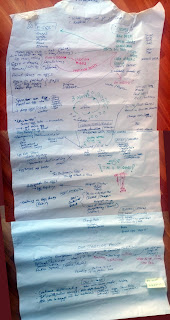Where are we after 5 days research with the three of us?
Prior to our days of collaborating with a group of local clowns and artists who responded. to our invitation, we gathered together what we were interested in taking forward with that group.
In order to make some sense of all of this, and to be able to communicate some of our direction of travel to people joining us, we found the categories below to be useful.
The plan for this new phase of the research was as follows:
1. Short Discursive Introduction
a. Our starting points
- decolonising clowning
- the third concerns of old trickster traditions, political activism and public spaces
b. What we've come up with so far
- see below for categories of the work
c. Our invitation to the collaborators
- the intention of the workshop is to simply continue in the same direction we have taken on previous days, continuing to explore, to ask questions in practice, to test ideas, to reflect. The presence of the collaborators will of course alter and influence what we are doing, and enable new things to happen. What we are not intending is to in any way teach r impart what we think we know. The project is research into WHAT WE DON'T KNOW. And the intended outcomes are that we shall know NEW TRHINGS at the end of it.
2. Some Activity Together
Games and exercises to mess around together
a. Naming game - circle saying own name and then others' in turn, progressively harder to keep track, with each person's turn ending whenever they get a name correct or there is laughter. Same but switching names around, giving people someone else's name.
b. Role game - dividing the labour: some get the job of putting everything away, some have the job of getting everything out, others have the job of having half the things away and half the things out.
c. Ball games - various rules, rule-breaking
3. Active Creation as a Group
a. Costume making
b. Out on the street
The categories of the work, presented ta the beginning and present as reference throughout:
- Eggs (the content, the props, the symbolic elements, the actions)
- Clown Roles and Relationships (different types of clowns, power interactions, how involved in action, how much to address onlookers)
- Costumes (materials, forms, face coverings, human/wild)
- Sound (languages, noise, nonsense)
- Places (locations in Athens)

Comments
Post a Comment